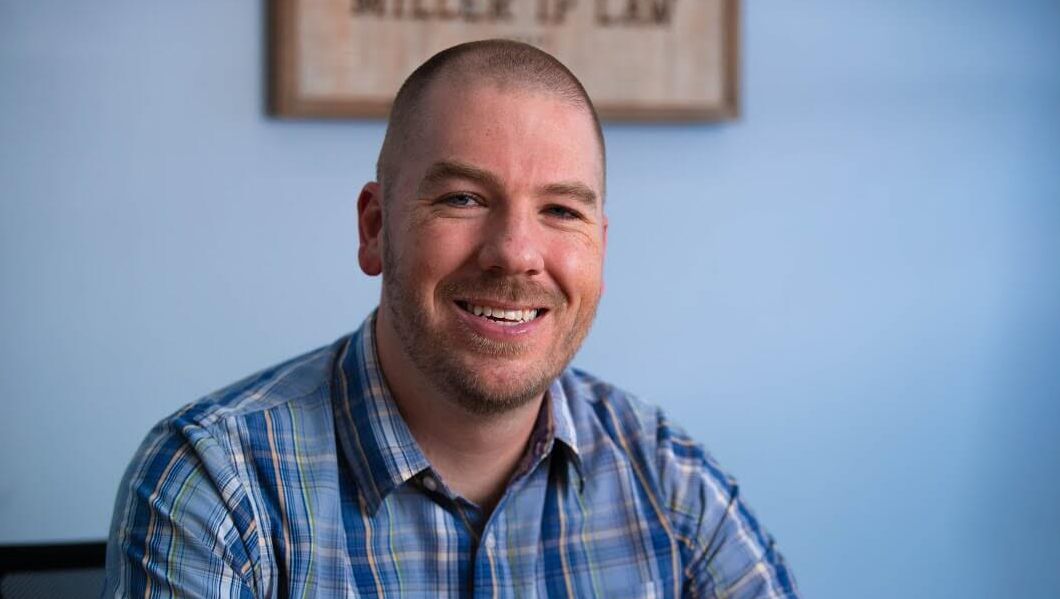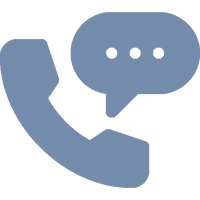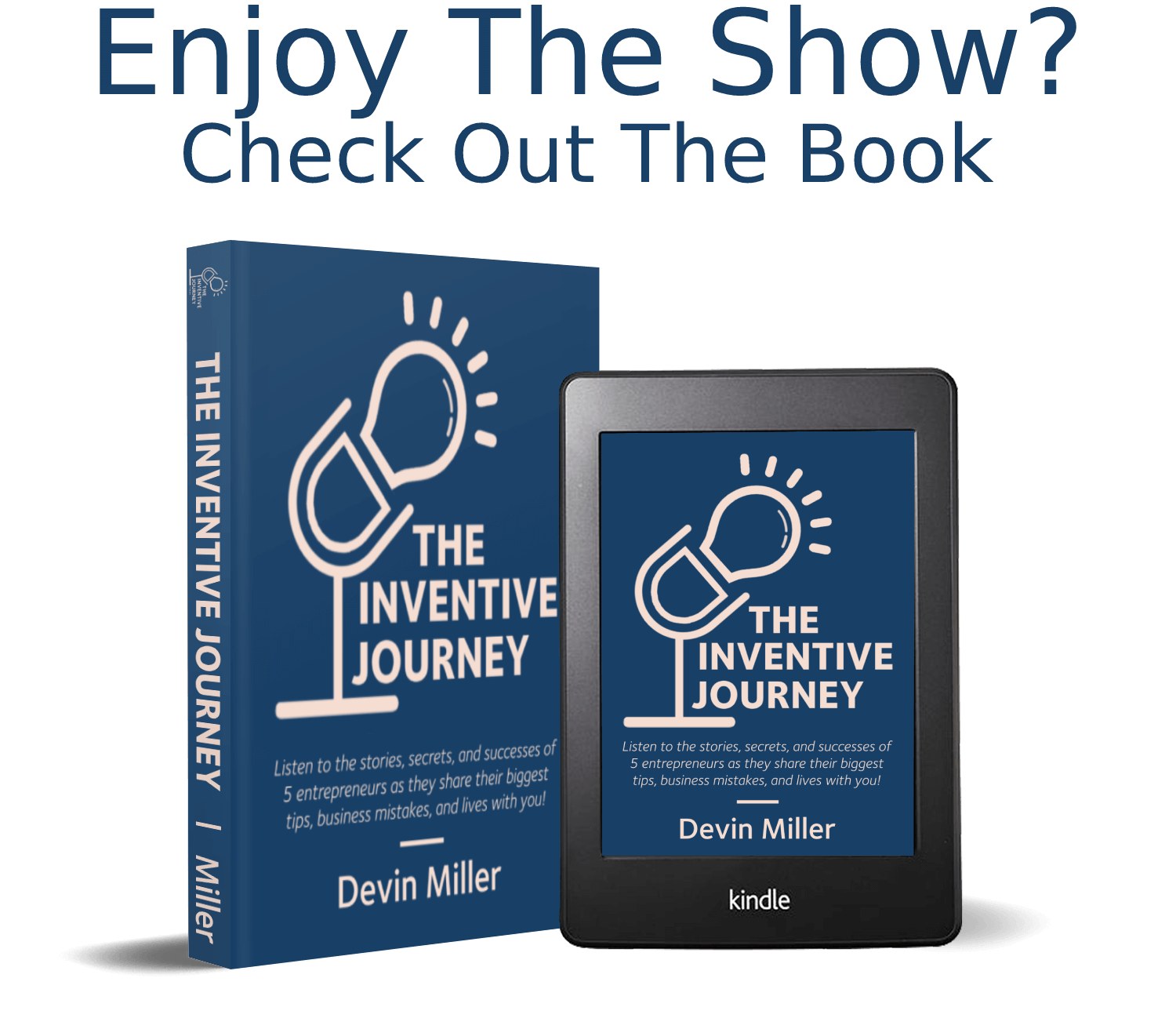How To Product Message
Ray McKenzie
Devin Miller
The Inventive Journey Podcast for Entrepreneurs1/25/2022
How to Product Message
The Inventive Journey

Starting and growing a business is a journey. On The Inventive Journey, your host, Devin Miller walks with startups along their different journeys startups take to success (or failure). You also get to hear from featured guests, such as venture firms and angel investors, that provide insight on the paths to a successful inventive journey.
Get New Episodes
Get 2 brand-new podcast episodes sent to you every week!
ai generated transcription
you need to write on one column what you think your messaging is for your product what you think your value proposition is for your product who you think your target customer is for your product and what people would use what people would say to describe your product on one side of it on the other side the other column is the feedback you get from people what actually do people say when you ask them those questions how do you get value from my product how would you describe my product who is who would be a perfect customer for your product and then compare those side by side and continuously do that that will lead you down the path of one we know who we're selling to we know how to talk to them we know what's important to them and we know what how to describe our product [Music] hey everyone this is devin miller here with another episode of the inventive expert i'm your host devin miller the serial entrepreneur that's grown several startups into seven and eight figure businesses as well as the founder and ceo of miller ip law where he helps startups and small businesses with their patents and trademarks you ever need help with yours just go to strategymeeting.com and we're always here to help now today we have another great guest on the podcast ray mckenzie and ray we're going to be talking a lot about product messaging so kind of what you should be thinking about product messaging how to get there how to nail down what you do how you do it kind of provide that value proposition also maybe i discussed a little bit about product development and enhancements and what you should be considering there and then also what makes uh the most sense for product development how you know doing that with different clients and and how you should be tackling that so a lot of great discussion and looking forward to it and with that much is an introduction welcome on the podcast ray all right thanks devin thanks for having me again good to talk hey my pleasure always always a good uh good conversation so um with that you know before we dive into it and for those that didn't catch your uh episode on the inventive journey um kind of introduce yourself a bit to the audience take a couple minutes and let them know kind of why you have experience in this area and what your background is and then we'll dive into the topics at hand definitely so uh ray mckenzie i'm founder and managing director of red beach advisors which is a technology management consulting company and then founder and ceo of starting point which is a workflow management and customer operations platform for consulting companies and service based agencies and so my background spans more than 20 years primarily working in technology and cyber security companies across various areas of service delivery um product strategy product management um product marketing uh business operations gosh professional services kind of run the gambit in terms of large and public companies all the way down to early stage startup companies um and with my background i've seen i've worked with a lot of large companies and products that have kind of you know to a certain extent kind of died off a little bit or flatlined and then i've worked in companies where the products are kind of moving upwards and on the upward slope and being adopted more and so uh you know it's interesting to talk to your audience specifically around product messaging you know what's worked for companies i've worked with what's worked for my startup starting point um and also how we kind of moved about developing what our messaging was and how we came to reach where we're at right now oh i think that that definitely uh makes sense and it's a great background and it is a great uh great introduction so with that let's dive into the the topic at hand which is kind of or it is product messaging and i think that uh you know it's one that's talked about a good amount and yet people oftentimes don't know how to actually get towards implementing in other words yeah i understand my product should have a message and people need to know why they should buy it or you know what we're offering and on the other hand there's a lot of businesses knowing that you're having that in mind that still fail on product messaging or people don't get that message or it doesn't come across clearly and so if you're saying especially for startup for a small business hey here's or you know product message is important got a check mark but now how do we go about actually doing it what are some of the things that on the kind of how to get started or what people should be considering as they get to work on the product messaging yeah definitely i think you know the first thing people have to understand is while they're building the product they have a vision of it themselves um it's it's very similar to the person who cooks and makes and eats their own food you know you obviously you feel that your food is good you cooked it you understand what it is you understand how you made it you feel that it's great however when you try to share it with other people that same message may not always be received the same way and so you have to figure out okay how do i get everyone else to understand what i've made how do i get everybody else to easily digest why this is important why this drives value and how this can help you and and some of those things don't always correlate you know when you're the product builder you're the company founder you you automatically know you more likely are the expert in many different areas surrounding your business however a majority of your customers may only know a piece of what you're building or they may not be an expert in the area and they're just looking for help and so how do you really translate your value proposition your product into their language and that takes a bit of time that's not always easy to do and so for us you know one of the things i've always done throughout my career working with legacy products as well as new products and going through this journey as a startup founder myself is interviewing people you know that's been the best thing i can do which is you build the product you show the product to people you digest their questions and record their questions or write down their questions and then you ask them to tell you how to describe your product and what it does and how it benefits them then if you go through that process then it becomes relatively easy to kind of guide and take those messages and understand them and sometimes you're going to talk to people that just don't understand it and they may not be your pro your product market fit they may not be the person who would use your product but the more people you talk to allows you to narrow who you're selling to who understands it and how they describe your product no and i think that's a great point you know oftentimes the best way to find out what people think if they understand your messaging and your product and that is is going out and talking with them and then describing it to them and seeing and it also you know i think one thing is the first time or two you're even more than the first time or two that you're going to describe your product you're probably your messaging isn't going to be as good as you think it is or people aren't going to grasp it as easily no matter you know your product well but conveying that information is going to be is going to be a much different task because now you have to simplify it and i think attorneys in the field that i work in are horrible about it in the sense that yeah they are very expert they know you know their various areas of law and you conveying why if somebody needs a patent or a trademark or why you're you're able to help somebody through a divorce or immigration law or tax law or whatever is it's a much different skill set to be able to explain that to people as to what your services are and how you do or what services you provide and why they need them as opposed to just knowing the actual you know how to do the work and so i think that that getting out and talking with people is definitely a great area to go for us to you know for one thing we went through as an early stage company and this is a failure of ours obviously we built the product we thought we had the right messaging we you know we have went out we bought built a product we talked to people who understood the product more in depth and the one question we didn't ask was how you would describe our product so out of all the interviews and all the demos when we were going through kind of our our beta phase of our product it was more so a hey does this feature look right or do you see value in this or hey are we are things positioned right within the product does this make it easy to use instead of describe our product to us or explain the problem were solved and so we went through a process of going through all those early interviews we did probably about 150. um then we thought we had our messaging down our products was relatively solid you know we launched our mvp next thing you know we go out we do a digital marketing campaign with our first messaging it absolutely bombs and fails and you know it generated maybe two leads out of however long we ran it out of two weeks and it just didn't go well just didn't so we stopped it you know and it just was like hey we're missing the point here we're missing something um and then i had a couple conversations with some of the people that we interviewed before and i i listened to an interview somebody did and they were like you should just ask how would people describe your product and the problem it solves and once we once we went back to that original control group of interviewees that led us down the path of where we're at right now which is solving the disconnected workflow experience for consultants and those interviews and that feedback was it was important now granted it didn't happen overnight this took a matter of six nine months to try to work through messaging work through refining work through our value proposition working through these interviews and talking to people you know and it doesn't happen overnight and more than likely if you're starting a business opening a company you know developing a product developing a service it's going to go through multiple iterations of how you're going to get to that and it's going to continuously change and our product is still changing because it's really early in our process you know we're a year and a half to market so it's one of those things to where it just takes time it takes iterations it takes talking to people it takes control groups it takes interviews it takes you know getting some hard criticism at times and that makes your business your product and your messaging all that much better no i think that that definitely makes sense now that certainly agree with that but now one thing that i would uh or kind of throw out as a question to you is you kind of have two cent or two odds or two ends of the spectrum that people oftentimes operate on as a especially you know first-time startup small business but even sometimes experience which is on the one hand you say i am the customer or i'm gonna go with my gut or i know the marketplace and they don't do any product you know feedback they don't get any messy they don't get any asking people questions and then you have the other extreme which is you have people that are forever kind of just telling the idea and asking people what they think but they never actually get started in building and they never actually get things going because they're always getting more feedback and tweaking the idea and tweaking the messaging and they never have to actually build and sell because they don't want to get it wrong and so they have kind of that fear of getting it wrong and so they never actually do it so kind of what is there a sweet spot or is there a way to balance to between getting no product feedback so you don't know if your messaging is working and also getting way too much to where you never actually get the product going any thoughts on how you balance that i think i think you have to go in thinking mistakes are going to be made and adaptation is just part of the process you know um i think if you go into it as i've got to build just the perfect product i've got to build um the perfect messaging i've got to have the perfect website i've got to this this this your your products your service your business is never going to be perfect in day one it never is and so if you understand that from the beginning then you're able to adjust it accordingly from there which is okay let me let me just get the baseline messaging in terms of what we're doing let's get some interviews let's build our product let's show our product people and let's have them kind of interview and let's go ask questions and they can figure out what the value proposition is and have them regurgitate that back to us that's fine but you don't you want to continuously take feedback that's something that you always have to do but you can't build something from just your perspective and your lens you know talk to your customers but also like you said there's that balance of i've got to put something out but i need to be willing to accept criticism and continuous feedback and so i think that's one of the things that has worked well in our development is that even though we had a vision of what the product is we continuously take feedback e on every call that we are on regarding our product you know which is ask questions and tell me hey tell me give me an idea is there anything that can make our solution easier for you or any ideas and that always allows us to add more features more products figure out what's going on change our messaging you know we early on we had people say oh i thought our i thought your father did this but instead it does this that's a flag which is like hey our messaging isn't right you know or we have people say and recently since we've changed our messaging in the last four months people have said oh this is exactly what we're looking for now what questions and you know whether it's using you guys an example and what you've done or just and more in general should you be asking i guess two things and i always try and avoid compound questions but here we are what questions should you be asking or you know how did you find out what is are they perceiving but he and then even more so or equally you know how are you asking those questions was that were you calling your every single customer or client as they came on board and regular check-ins was it more of an email follow-up was it asking for reviews was it asking for feedback or kind of how did you what questions did you ask but also how did you go about asking them or interacting with the clients yeah the how we executed was through demos and live conversations um we didn't really do the survey bit as much um the survey or email bit um you know everybody gets a ton of emails people hate filling out surveys uh the best way is to just have a conversation and this is a saying i kind of routinely say is you know there's one thing that's always free and that's people's opinion and so you know once you start talking to people and you ask them a certain open-ended question they're more than likely going to share how they feel about it or their opinion about and then once they're open to sharing their opinions everybody's got a lot of them so all you have to do is record and listen and listen and listen and so the most effective way for us has been actually doing demos of our product showing it to people walking them through a use case and then them giving their feedback as to can it do this can it do that oh this would help me do this if i have a pain point here it would be great if your tool could help us solve this challenge um and then at the end the last question we always ask is tell us what our product does for you or tell us how our product can help you and that helps us get down to that final messaging piece that we're always looking for you know and so interactive conversations asking open-ended questions taking 30 minutes 45 minutes based upon how much time you have available and then always asking that question of how does our product help you or can it help you and then just letting people kind of talk and give their feedback and then you know obviously some of the feedback may be bad and they can say i can't use this or now this is too difficult or um there's too many steps or it can be something that's positive but you also need to be willing to take that feedback and take that criticism so i think one of the things is as you're building companies you're building messaging you know embrace mistakes be willing to take criticism and take people's opinions because sometimes the opinions will be very very helpful in terms of your journey oh and i think that that uh definitely is a is a great way to attach it and to approach it and i think that you know a lot of times we want to because emails are easy right in other words hey fill out this form or do an email one is you're gonna get you're directing them when you have a specific format or template that they're going to fill out what do you think about the product you're going to a lot of times you're going to get not the very helpful feedback they're not going to talk as much they're going to if they do it most time they ignore it they're going to try and just breeze through it because they're doing it to you it's just to be nice there's a courtesy whereas if you can get people talking about your product talking about what they like or don't like i i love the approach because i think it helps them to open back up and you're going to get learn things that you would otherwise wouldn't have caught when you go through that or go through that experience of just talking with them and seeing what feedback they have and what they think and where what they think is the value there yeah it's um but the one the one thing that's interesting and this has been our approach from the beginning the more people we talk to certain trends will start to rise to the top so you know whether you're doing an email or whether you're doing a survey you know based upon the number of responses you're going to see certain themes come up and what we've done is as we've talked to more and more people we listen to everybody we take everybody's feedback into account but then the trends that repeat themselves move higher on the board in terms of what needs to be shared you know like um and that goes for product development feedback that also goes for messaging feedback which is some people are going to see it from if you ask two people you're gonna get you could get two differing opinions on however if you ask a hundred people over the course statistically you're going to see some trends develop and that's what you want to focus on especially when it comes to messaging no and i like that because i mean i think that the the difficulty is is you know you can't listen to every negative feedback because some of it is just going to you know sometimes people's feedback is going to be very specific to them sometimes you're just going to get someone that's critical of everything and you don't want to be forever chasing down every possible rabbit hole to try and please every customer just don't have the time and it's probably not going to have that return that you're looking for and yet i love the approach that if you're saying hey what is the reoccurring theme what are we hearing from multiple customers and they're not going to say the exact same way but if you're saying hey here's what really they're they are telling us and we're hearing this in different ways in different way different manners then you're going to then be able to figure out what to focus on and what to target and how to improve either the messaging and or the product and we've talked a lot about the messaging but it can also be that product development that enhancements that changes because you may say hey we love the messaging if it did what you said it would do it would be great but now here's my problem here's where it's not working here here's where i'm having a hard time using your product it's also very valuable yeah definitely no i i think it's it's on both sides you know just interviews are very important i i think just talking to either trying to when you're trying to narrow down your target customer interviews are important when you're trying to figure out what you're messaging what works what doesn't work interviews are important when you're trying to figure out where your product should go or what your customers want in your product interviews are important and then just collecting that feedback across the board can be so helpful because you're going to find out who actually your value proposition sticks for then you're able to find out how to talk to your target customer and then you're able to continuously please your target customer because they're telling you how to improve your product more and more now and i think that that definitely makes sense and absolutely agree with that so well we've hit on a lot of things throughout the podcast a lot of i think takeaways and i'd say the overall theme is talk to your customers which is a great thing but you know they're even within that it's how do you talk with them what do you talk to them about how do you take that feedback what does that feedback mean and all those things so a lot of things that people could and probably should be doing within the business and yet as a business owner you always have way more things to do than ever you have time to do them so as uh you know as we wrap up the podcast that people are looking to say okay if you're to give them just kind of one thing to get started on one thing that they should be getting to work on or otherwise executing on they will get them started down this path to improve their product and their product messaging what would that one thing be i would say to get started on the pathway of it is to i'd say right you take a piece of paper or you take a document and you split it into two columns and you need to write on one column what you think your messaging is for your product what you think your value proposition is for your product who you think your target customer is for your product and what people would use what people would say to describe your product on one side of it on the other side the other column is the feedback you get from people what actually do people say when you ask them those questions how do you get value from my product how would you describe my product who is who would be a perfect customer for your product and then compare those side by side and continuously do that that will lead you down the path of one we know who we're selling to we know how to talk to them we know what's important to them and we know what how to describe our product to them and that's where i would start first and foremost the two-column sheet and then you know start talking to people hey i think that that is uh definitely some great takeaways and and certainly plenty to get started on and execute with so well thank you for coming on the podcast it has been a fun it's been a pleasure now for all of you that are listeners um you know if you can do us a favor make sure to click subscribe make sure to leave a review make sure to share with everyone because we want to make sure that we really can help as many startups and small businesses out there by helping them get garner and gain that expertise in the various areas that you need to be that be successful so if you can make sure to leave a leave a review subscribe and share that would be awesome um also if you ever need help with patents or trademarks or anything else with your uh business just go to strategymeeting.com grab some of us our time with us to chat here at miller iplot and we're always here to help well thank you again ray for coming on the podcast it's been a fun it's been a pleasure and wish the next leg of your journey even better than the last all right thanks a lot devon thanks for having me always great conversation absolutely [Music]















